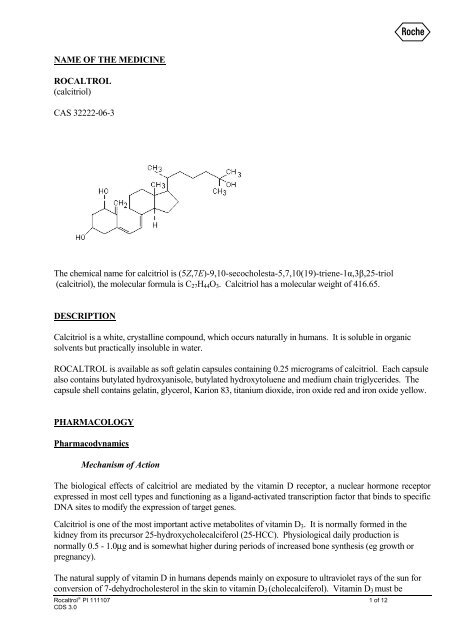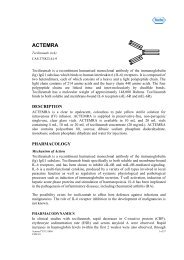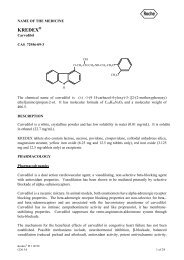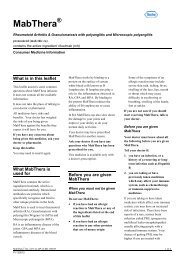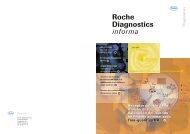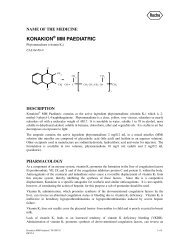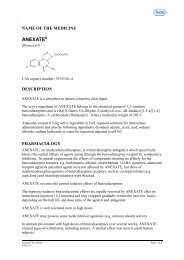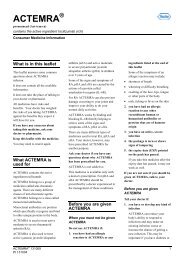Rocaltrol (calcitriol) - Product Information (PI) - Roche Australia
Rocaltrol (calcitriol) - Product Information (PI) - Roche Australia
Rocaltrol (calcitriol) - Product Information (PI) - Roche Australia
You also want an ePaper? Increase the reach of your titles
YUMPU automatically turns print PDFs into web optimized ePapers that Google loves.
R<br />
NAME OF THE MEDICINE<br />
ROCALTROL<br />
(<strong>calcitriol</strong>)<br />
CAS 32222-06-3<br />
The chemical name for <strong>calcitriol</strong> is (5Z,7E)-9,10-secocholesta-5,7,10(19)-triene-1α,3β,25-triol<br />
(<strong>calcitriol</strong>), the molecular formula is C 27 H 44 O 3 . Calcitriol has a molecular weight of 416.65.<br />
DESCRIPTION<br />
Calcitriol is a white, crystalline compound, which occurs naturally in humans. It is soluble in organic<br />
solvents but practically insoluble in water.<br />
ROCALTROL is available as soft gelatin capsules containing 0.25 micrograms of <strong>calcitriol</strong>. Each capsule<br />
also contains butylated hydroxyanisole, butylated hydroxytoluene and medium chain triglycerides. The<br />
capsule shell contains gelatin, glycerol, Karion 83, titanium dioxide, iron oxide red and iron oxide yellow.<br />
PHARMACOLOGY<br />
Pharmacodynamics<br />
Mechanism of Action<br />
The biological effects of <strong>calcitriol</strong> are mediated by the vitamin D receptor, a nuclear hormone receptor<br />
expressed in most cell types and functioning as a ligand-activated transcription factor that binds to specific<br />
DNA sites to modify the expression of target genes.<br />
Calcitriol is one of the most important active metabolites of vitamin D 3 . It is normally formed in the<br />
kidney from its precursor 25-hydroxycholecalciferol (25-HCC). Physiological daily production is<br />
normally 0.5 - 1.0μg and is somewhat higher during periods of increased bone synthesis (eg growth or<br />
pregnancy).<br />
The natural supply of vitamin D in humans depends mainly on exposure to ultraviolet rays of the sun for<br />
conversion of 7-dehydrocholesterol in the skin to vitamin D 3 (cholecalciferol). Vitamin D 3 must be<br />
<strong>Rocaltrol</strong> ® <strong>PI</strong> 111107 1 of 12<br />
CDS 3.0
R<br />
metabolically activated in the liver and the kidney before it is fully active as a regulator of calcium and<br />
phosphorus metabolism at target tissues. The initial transformation of vitamin D 3 is catalysed by a vitamin<br />
D 3 -25-hydroxylase enzyme (25-OHase) present in the liver, and the product of this reaction is<br />
25-hydroxyvitamin D 3 [25-(OH) D 3 ]. Hydroxylation of 25-(OH) D 3 occurs in the mitochondria of kidney<br />
tissue, activated by the renal 25-hydroxyvitamin D 3 -1 alpha-hydroxylase (alpha-OHase), to produce<br />
1,25-(OH)2 D 3 (<strong>calcitriol</strong>), the active form of vitamin D 3 .<br />
Calcitriol binds to an intracellular receptor, a member of the steroid receptor superfamily. The <strong>calcitriol</strong>receptor<br />
complex interacts with specific DNA sequences that regulate transcription and protein synthesis<br />
in a variety of cells including osteoblasts, mucosal cells of the intestine, renal tubular cells and parathyroid<br />
cells. The changes in protein synthesis induced in these cells by <strong>calcitriol</strong> are responsible for its profound<br />
physiological effects. A vitamin D-resistant state exists in uraemic patients because of the failure of the<br />
kidney to convert precursors to the active compound. The uraemic state may also inhibit the binding of<br />
the <strong>calcitriol</strong> receptor to its specific DNA responsive elements.<br />
The key role of <strong>calcitriol</strong> in the regulation of bone and calcium homeostasis, which includes stimulating<br />
effects on osteoblastic activity in the skeleton, provides a sound pharmacological basis for its therapeutic<br />
effects in osteoporosis. Treatment of established osteoporosis with <strong>calcitriol</strong> is associated with an increase<br />
in bone density and a reduction in new vertebral fractures. Established osteoporosis is defined as the<br />
finding of: bone mineral density measurements of 2 or more standard deviations below the gender<br />
specific peak bone mass; or the presence or history of osteoporotic fracture. Calcitriol also reduces<br />
bone loss associated with corticosteroid therapy.<br />
In patients with marked renal impairment, synthesis of endogenous <strong>calcitriol</strong> is correspondingly limited or<br />
may even cease altogether. This deficiency plays a key role in the development of renal osteodystrophy.<br />
In patients with renal osteodystrophy, administration of <strong>calcitriol</strong> normalises reduced intestinal absorption<br />
of calcium, hypocalcaemia, increased serum alkaline phosphatase and serum parathyroid hormone<br />
concentration.<br />
In patients with hypophosphataemic rickets and hypophosphataemia, treatment with <strong>calcitriol</strong> reduces<br />
tubular elimination of phosphates and, in conjunction with concurrent phosphate treatment, corrects some<br />
skeletal abnormalities.<br />
Pharmacokinetics<br />
Absorption<br />
Calcitriol is rapidly absorbed from the intestine. Peak serum concentrations (above basal values) were<br />
reached within 3 to 6 hours following oral administration of single doses of 0.25 to 1.0 microgram of<br />
ROCALTROL.<br />
Distribution<br />
Following a single oral dose of 0.5 microgram mean serum concentrations of <strong>calcitriol</strong> rose from a<br />
baseline value of 40.0 + 4.4 (S.D.) pg/ml to 60.0 + 4.4 pg/ml at 2 hours and declined to 53.0 + 6.9 at 4<br />
hours, 50 + 7.0 at 8 hours, 44 + 4.6 at 12 hours and 41.5 + 5.1 at 24 hours.<br />
Calcitriol and other vitamin D metabolites are transported approximately 99.9% bound to specific plasma<br />
proteins in the blood.<br />
Metabolism<br />
Calcitriol is hydroxylated and oxidized by CYP24A1.<br />
<strong>Rocaltrol</strong> ® <strong>PI</strong> 111107 2 of 12<br />
CDS 3.0
<strong>Rocaltrol</strong> ® <strong>PI</strong> 111107 3 of 12<br />
CDS 3.0<br />
R<br />
Several metabolites of <strong>calcitriol</strong>, each exerting different vitamin D activities, have been identified: 1α,25-<br />
dihydroxy-24-oxo-cholecalciferol, 1α,23,25-trihydroxy-24-oxo-cholecalciferol, 1α,24R,25-<br />
trihydroxycholecalciferol, 1α,25R-dihydroxycholecalciferol-26,23S-lactone, 1α,25S,26-<br />
trihydroxycholecalciferol, 1α25-dihydroxy-23-oxo-cholecalciferol, 1α25R,26-trihydroxy-23-oxocholecalciferol<br />
and 1α-hydroxy-23-carboxy-24,25,26,27-tetranorcholecalciferol. 1α,25Rdihydroxycholecalciferol-26,23S-lactone<br />
is the major metabolite in humans.<br />
Elimination<br />
The elimination half-life of <strong>calcitriol</strong> from serum was found to range from 3 to 6 hours. However, the<br />
pharmacological effect of a single dose of <strong>calcitriol</strong> lasts about three to five days. Enterohepatic recycling<br />
and biliary excretion occur. Following intravenous administration of radiolabelled <strong>calcitriol</strong> in normal<br />
subjects, approximately 27% and 7% of the radioactivity appeared in the faeces and urine respectively,<br />
within 24 hours. When a 1 microgram oral dose of radiolabelled <strong>calcitriol</strong> was administered to normals,<br />
approximately 10% of the total radioactivity appeared in urine within 24 hours. Cumulative excretion of<br />
radioactivity on the sixth day following intravenous administration of radiolabelled <strong>calcitriol</strong> averaged<br />
16% in urine and 49% in faeces.<br />
There is evidence that maternal <strong>calcitriol</strong> may enter the fetal circulation.<br />
CLINICAL TRIALS<br />
Females with osteoporosis<br />
The pathophysiology of osteoporosis is essentially the same in females and males. There are few data<br />
on the safety and efficacy of ROCALTROL on fracture rates and bone mineral density in<br />
premenopausal women.<br />
Post-menopausal osteoporosis<br />
Calcitriol versus calcium<br />
The pivotal evidence for the efficacy of ROCALTROL in post-menopausal osteoporosis is provided<br />
by a three year, open label multicentre randomised comparison of <strong>calcitriol</strong> versus calcium in 432<br />
patients (<strong>calcitriol</strong> n = 213, calcium n = 219). Vertebral fracture rate was assessed by X-ray evidence.<br />
Treatment with <strong>calcitriol</strong> 0.25 microgram twice daily for three years resulted in a three-fold reduction<br />
in the rate of new vertebral fractures in women with post-menopausal osteoporosis compared with<br />
calcium supplementation of 1000 mg daily. There was a reduction in the number of patients with new<br />
fractures, the number of new fractures per se and the fracture rate expressed as fractures per 100<br />
patient years in the <strong>calcitriol</strong> group when compared to the calcium group. The differences between<br />
<strong>calcitriol</strong> and calcium groups increased over the three year study period, reaching significance by the<br />
second year. Serum calcium and creatinine were monitored regularly and dosage was halved if levels<br />
became elevated. Hypercalcaemia was reported in two patients.<br />
Calcitriol versus placebo<br />
A randomised, double blind, placebo-controlled trial was conducted in 40 patients (<strong>calcitriol</strong> n = 18,<br />
placebo n = 22). ROCALTROL was increased from an initial dose of 0.25 microgram twice daily<br />
until hypercalcaemia developed, at which point the dosage was adjusted and calcium intake reduced to<br />
maintain stable serum and urinary calcium. Dietary calcium was maintained at 1000 mg per day and<br />
400 IU vitamin D was administered to each patient. After two years, ROCALTROL treated patients<br />
had an increase in spine bone density of 1.94% measured by dual photon absorptiometry compared to<br />
a decrease of 3.92% in patients on placebo (p = 0.001). The sample size was too small to show positive<br />
data on fracture rate after two years.
R<br />
Phase II studies of ROCALTROL in post-menopausal osteoporosis were undertaken in the USA and<br />
involved a total of 93 patients. The primary endpoint was effect on vertebral fracture rates. Dose<br />
titration resulted in a mean dose of 0.5 to 0.6 microgram/day. Two studies were very similar, with an<br />
initial two month placebo treatment for all patients, followed by a ten month double-blind comparison<br />
of ROCALTROL and placebo, with a subsequent extension of 12 to 30 months during which all<br />
patients received ROCALTROL. The third study compared ROCALTROL with placebo in an initial<br />
six month single-blind evaluation, with a subsequent open phase of up to 24 months ROCALTROL<br />
treatment. Dietary calcium was supplemented to 600 mg per day in the two double-blind trials. A<br />
highly significant reduction was noted in the fracture rate in patients treated with ROCALTROL in<br />
comparison with placebo in the three double blind studies. Overall, there was a statistically significant<br />
association between ROCALTROL treatment and the suppression of fractures. Calcium absorption<br />
was significantly increased in the ROCALTROL groups in all three studies.<br />
Males with osteoporosis<br />
There are few data on the safety and efficacy of ROCALTROL on fracture rates and bone mineral<br />
density in osteoporotic men.<br />
Calcitriol versus calcium<br />
A randomised double-blind, placebo-controlled pilot trial assessed the efficacy of <strong>calcitriol</strong> 0.25<br />
micrograms twice daily versus calcium 500 mg twice daily for 24 months in men with osteoporosis.<br />
Twenty-one men were randomised to receive <strong>calcitriol</strong> and 20 to receive calcium. Due to the size of<br />
the study no valid conclusions were drawn regarding the efficacy in terms of bone mineral density<br />
(BMD) and vertebral fracture rates.<br />
Corticosteroid-induced osteoporosis<br />
A randomised, double blind, placebo and comparator-controlled trial was conducted in 103 enrolled<br />
male and female patients with rheumatic, immunological or respiratory disease. The subjects enrolled<br />
within four weeks of starting long-term corticosteroid therapy. The three treatment groups were the<br />
placebo group (n = 29, calcium 1000 mg/day), <strong>calcitriol</strong> group (n = 34, oral calcium 1000 mg/day,<br />
<strong>calcitriol</strong> 0.5 - 1 microgram/day) and the <strong>calcitriol</strong> plus calcitonin group (n = 29, oral calcium 1000<br />
mg/day, <strong>calcitriol</strong> 0.5 - 1 microgram/day, intranasal calcitonin 400 IU/day). Each treatment group<br />
received active treatment for 12 months and was followed up for a further 12 months.<br />
The primary efficacy end-point was bone mineral density measured at the lumbar spine, femoral neck<br />
and distal radius by photon absorptiometry. Serum levels of parathyroid hormone, 25-hydroxyvitamin<br />
D, 1,25-dihydroxyvitamin D and osteocalcin and urinary levels of calcium, hydroxyproline and<br />
creatinine were also measured. The bone density measurements and biochemical analyses were made<br />
at baseline and then every four months for two years. Serum calcium was measured at one, three and<br />
five weeks and every two months thereafter.<br />
After the first year both treatment groups showed a similar and statistically significant reduction in<br />
bone loss at the lumbar spine but not at the femoral neck or distal radius compared to the placebo<br />
group. In the second year, this reduction in bone loss was no longer apparent in the <strong>calcitriol</strong> group.<br />
However, this group did receive a higher cumulative dose of corticosteroids during the second year.<br />
The study medications were generally well tolerated with few adverse effects. The most frequent<br />
events were hypercalcaemia and rhinorrhoea. Hypercalcaemia was seen in one placebo group patient,<br />
<strong>Rocaltrol</strong> ® <strong>PI</strong> 111107 4 of 12<br />
CDS 3.0
R<br />
one <strong>calcitriol</strong> group patients and eight <strong>calcitriol</strong> plus calcitonin group patients. Other less frequently<br />
reported adverse events included rash, headache and gastrointestinal symptoms.<br />
INDICATIONS<br />
ROCALTROL is indicated for the treatment of established osteoporosis diagnosed by objective measuring<br />
techniques, such as densitometry, or by radiographic evidence of atraumatic fracture.<br />
ROCALTROL is also indicated for the prevention of corticosteroid-induced osteoporosis in patients<br />
commencing oral steroid therapy in a dose and regimen expected to result in a significant bone loss.<br />
ROCALTROL is indicated in the treatment of hypocalcaemia in patients with uraemic osteodystrophy,<br />
hypoparathyroidism and in hypophosphataemic rickets.<br />
CONTRAINDICATIONS<br />
Hypercalcaemia or Vitamin D toxicity.<br />
Hypersensitivity to <strong>calcitriol</strong> or drugs of the same class, or any of the excipients in ROCALTROL.<br />
PRECAUTIONS<br />
Concomitant therapy with other vitamin D compounds<br />
Since ROCALTROL is the most potent metabolite of vitamin D available, other vitamin D compounds<br />
should be withheld during treatment in order to avoid the development of hypervitaminosis D.<br />
If patients are "changed over" from ergocalciferol to <strong>calcitriol</strong> it may take many months for blood levels of<br />
ergocalciferol to return to pre-treatment values. Overdosage of any form of vitamin D is dangerous (see<br />
also Overdosage). Chronic hypercalcaemia can lead to generalised vascular calcification, nephrocalcinosis<br />
and other soft-tissue calcification.<br />
Hypercalcaemia<br />
A strong relationship exists between <strong>calcitriol</strong> therapy and the development of hypercalcaemia. In some<br />
trials in uraemic osteodystrophy, up to 40% of patients receiving <strong>calcitriol</strong> treatment became<br />
hypercalcaemic.<br />
Sudden increases in calcium consumption due to dietary change (e.g. dairy products) or injudicious<br />
calcium supplements may precipitate hypercalcaemia. Patients and relatives should receive instruction<br />
in dietary management, be informed about the symptoms of hypercalcaemia, and be warned of the<br />
consequences of not adhering to dietary recommendations. Although an adequate dietary intake of<br />
calcium is important in patients with postmenopausal osteoporosis, <strong>calcitriol</strong> does increase calcium<br />
absorption in these patients and calcium supplements may lead to hypercalcaemia and are not<br />
recommended unless the dietary intake is clearly inadequate. (See DOSAGE AND<br />
ADMINISTRATION, <strong>Information</strong> for the Patient and ADVERSE EFFECTS).<br />
In patients with normal renal function, chronic hypercalcaemia may be associated with an increase in<br />
serum creatinine.<br />
<strong>Rocaltrol</strong> ® <strong>PI</strong> 111107 5 of 12<br />
CDS 3.0
<strong>Rocaltrol</strong> ® <strong>PI</strong> 111107 6 of 12<br />
CDS 3.0<br />
R<br />
Serum phosphate levels<br />
Calcitriol raises serum inorganic phosphate levels. While this is a desirable effect in patients with<br />
hypophosphataemic states, caution must be taken in patients with renal failure. (See PRECAUTIONS,<br />
Ectopic calcification).<br />
Hypophosphataemic Rickets<br />
Patients with hypophosphataemic rickets (familial hypophosphataemia) should pursue their oral phosphate<br />
therapy. However, the possible stimulation of intestinal phosphate absorption may modify the requirement<br />
for phosphate supplements. During the stabilisation phase of treatment with ROCALTROL, serum<br />
calcium levels should be checked at least twice weekly (see DOSAGE AND ADMINISTRATION,<br />
Laboratory Monitoring).<br />
Ectopic calcification<br />
Calcitriol may increase plasma phosphate levels. While this effect is desirable in hypophosphataemic<br />
osteomalacia, it may cause ectopic calcification, especially in patients with renal failure. Plasma<br />
phosphate levels should be kept normal in such patients by the oral administration of phosphate binding<br />
agents.<br />
Patients with normal renal function who are taking ROCALTROL should avoid dehydration. Adequate<br />
fluid intake should be maintained.<br />
Immobilisation<br />
Patients immobilised after surgical procedures are more at risk of developing hypercalcaemia, therefore<br />
more frequent monitoring is recommended.<br />
Use in patients with impaired renal function<br />
Special care should be taken when administering ROCALTROL to patients with renal dysfunction. More<br />
frequent monitoring in these patients is appropriate (see DOSAGE AND ADMINISTRATION).<br />
Use in Children<br />
Paediatric patients on long-term treatment with <strong>calcitriol</strong> are at risk of development of nephrocalcinosis.<br />
The younger the age at the commencement of therapy, and the higher the dose of <strong>calcitriol</strong> needed, the<br />
greater the risk. The drug should be used only if the benefits clearly outweigh the risks.<br />
Use in the Elderly<br />
It is advised that in elderly patients suffering from ischaemic heart disease, serum calcium levels should be<br />
carefully monitored. If hypercalcaemia is observed, <strong>calcitriol</strong> therapy should be suspended immediately. It<br />
should also be remembered that geriatric patients receive many other drugs and that their compliance may<br />
not be ideal.<br />
Carcinogenicity/mutagenicity<br />
Long term animal studies have not been conducted to evaluate the carcinogenic potential of <strong>calcitriol</strong>.<br />
Calcitriol is not mutagenic in vitro in the Ames test. No significant effects of <strong>calcitriol</strong> on fertility and/or<br />
general reproductive performances were observed in a study in rats at oral doses of up to 0.3<br />
micrograms/kg (approximately 3 times the maximum recommended dose based on body surface area).<br />
Use in Pregnancy<br />
Pregnancy category B3.<br />
There are no adequate and well-controlled studies in pregnant women. Calcitriol has been found to be<br />
teratogenic in rabbits when given at doses of 0.08 and 0.3 micrograms/kg (approximately 1 and 5 times the
R<br />
maximum recommended dose based on mg/m 2 ). All 15 fetuses in 3 litters at these doses showed external<br />
and skeletal abnormalities. However, none of the other 23 litters (156 fetuses) showed external and<br />
skeletal abnormalities compared to controls. Teratogenicity studies in rats up to 0.3 micrograms/kg<br />
(approximately twice the maximum recommended dose based on mg/m 2 ) showed no evidence of<br />
teratogenic potential.<br />
Calcitriol should be used during pregnancy only if the potential benefit justifies the potential risk to the<br />
fetus.<br />
Use in Lactation<br />
It should be assumed that exogenous <strong>calcitriol</strong> passes into the breast milk. In view of the possible adverse<br />
effects on the infant, mothers should not breast-feed while taking ROCALTROL.<br />
Effects on Laboratory Tests<br />
ROCALTROL affects serum calcium levels and serum phosphate levels (see PRECAUTIONS:<br />
Hypercalcaemia and Serum Phosphate Levels and DOSAGE AND ADMINISTRATION: Laboratory<br />
Monitoring). It is essential that regular monitoring of serum calcium concentration be performed during<br />
therapy with ROCALTROL.<br />
INTERACTIONS WITH OTHER MEDICINES<br />
Since <strong>calcitriol</strong> is one of the most important active metabolites of vitamin D 3 , pharmacological doses of<br />
vitamin D and its derivatives should be withheld during treatment with ROCALTROL to avoid possible<br />
additive effects and hypercalcaemia.<br />
In patients being treated for osteoporosis, calcium-containing preparations should be avoided unless<br />
required for specific dietary purposes.<br />
Cholestyramine has been reported to reduce intestinal absorption of fat soluble vitamins; as such, it may<br />
impair intestinal absorption of ROCALTROL.<br />
A relationship of functional antagonism exists between vitamin D analogues, which promote calcium<br />
absorption, and corticosteroids, which inhibit it.<br />
Magnesium containing antacids and ROCALTROL should not be used concomitantly, because such use<br />
may lead to the development of hypermagnesaemia.<br />
ROCALTROL should be given cautiously to patients on digitalis because hypercalcaemia in such patients<br />
may precipitate cardiac arrhythmias.<br />
The concomitant use of thiazide diuretics may precipitate hypercalcaemia.<br />
Since ROCALTROL also has an effect on phosphate transport in the intestine, kidneys and bones, the<br />
dosage of phosphate-binding agents must be adjusted in accordance with the serum concentration (normal<br />
value: 0.6 - 1.6 mmol/L).<br />
Administration of enzyme inducers such as phenytoin or phenobarbital may lead to increased metabolism<br />
and hence reduced serum concentrations of <strong>calcitriol</strong>. Therefore, higher doses of <strong>calcitriol</strong> may be<br />
necessary if these drugs are administered simultaneously.<br />
<strong>Rocaltrol</strong> ® <strong>PI</strong> 111107 7 of 12<br />
CDS 3.0
R<br />
ADVERSE EFFECTS<br />
Clinical Trials<br />
The adverse effects listed below reflect the experience from investigational studies of ROCALTROL, and<br />
the post-marketing experience.<br />
The most commonly reported adverse reaction was hypercalcaemia. Patients may also experience<br />
hypercalciuria.<br />
The adverse effects listed in Table 1 are presented by system organ class and frequency categories, defined<br />
using the following convention: Very common (≥1/10); common (≥1/100 to
R<br />
Since ROCALTROL exerts vitamin D activity in the body, adverse effects are, in general, similar to those<br />
encountered with excessive vitamin D intake.<br />
Hypercalcaemia related to mechanism of action is the most important side effect and is manageable by<br />
dose modification. Hypercalcaemia has been demonstrated not to be an issue for ROCALTROL in the<br />
treatment of postmenopausal osteoporosis at the recommended dosage of 0.25 microgram twice daily.<br />
However some women may require dose reductions (see PRECAUTIONS and DOSAGE AND<br />
ADMINISTRATION).<br />
Acute hypercalcaemia may give rise to cardiac arrhythmia and/or arrest.<br />
Signs and symptoms of vitamin D intoxication associated with hypercalcaemia include -<br />
Acute: decreased appetite, weakness, headache, somnolence, nausea, vomiting, dry mouth, constipation,<br />
abdominal pain or abdominal pain upper, muscle pain, bone pain and metallic taste.<br />
Chronic: muscular weakness, weight decreased, sensory disturbances, pyrexia, thirst, polydypsia,<br />
polyuria, , dehydration, apathy, growth retardation, nocturia, conjunctivitis (calcific), pancreatitis,<br />
photophobia, rhinorrhoea, hyperthermia, decreased libido, elevated BUN, albuminuria,<br />
hypercholesterolaemia, elevated AST and ALT, ectopic calcification, hypertension, cardiac arrhythmias,<br />
urinary tract infections and, rarely, overt psychosis.<br />
Prolonged chronic hypercalcaemia or concurrent hypercalcaemia and hyperphosphataemia of > 1.9<br />
mmol/L, calcinosis may occur; this can be seen radiographically.<br />
Hypersensitivity reactions, including rash, pruritus, erythema and urticaria may occur in susceptible<br />
individuals.<br />
Laboratory Abnormalities<br />
In patients with normal renal function, chronic hypercalcaemia may be associated with an increase in<br />
serum creatinine.<br />
DOSAGE AND ADMINISTRATION<br />
The optimal daily dose of ROCALTROL must be carefully determined for each patient and indication.<br />
Dosage optimisation should be accompanied by regular monitoring of serum calcium concentration. If<br />
hypercalcaemia occurs, the drug should be immediately discontinued until normocalcaemia ensues.<br />
Adults<br />
Osteoporosis<br />
Established Osteoporosis:<br />
The recommended dose of ROCALTROL is 0.25 microgram twice daily. If a satisfactory response is not<br />
obtained with this dose, it may be increased, with regular serum calcium monitoring, to a maximum of 0.5<br />
microgram twice daily. This increased dose should rarely be necessary.<br />
Corticosteroid-Induced Osteoporosis:<br />
<strong>Rocaltrol</strong> ® <strong>PI</strong> 111107 9 of 12<br />
CDS 3.0
R<br />
The recommended dose is 0.25 microgram twice daily for steroid doses equivalent to < 10 mg/day of oral<br />
prednisone increasing to 0.75 microgram/day for steroid doses > 10 mg/day oral prednisone.<br />
Dietary calcium intake should not exceed 1000 mg/day (See PRECAUTIONS, Hypercalcaemia).<br />
Other Indications<br />
Uraemic osteodystrophy:<br />
The recommended initial dose of ROCALTROL is 0.25 microgram/day. If a satisfactory response in the<br />
biochemical parameters and clinical manifestations of the disease state is not observed, dosage may be<br />
increased by 0.25 microgram/day at intervals of two to four weeks. Patients with normal or only slightly<br />
reduced serum calcium levels may respond to ROCALTROL doses of 0.25 microgram every other day.<br />
Most patients undergoing haemodialysis respond to doses between 0.5 and 1 microgram daily.<br />
Hypoparathyroidism and rickets:<br />
The recommended initial dose of ROCALTROL is 0.25 microgram per day given in the morning. If a<br />
satisfactory response in the biochemical parameters and clinical manifestations of the disease are not<br />
observed, the dose may be increased at intervals of two to four weeks.<br />
Malabsorption is occasionally noted in patients with hypoparathyroidism, therefore larger doses of<br />
ROCALTROL may be needed.<br />
Paediatric<br />
The doses are similar to those used in adults with greater variability between subjects. Patients in the one<br />
to five year age group with hypoparathyroidism have usually been given 0.25 to 0.75 microgram daily.<br />
Geriatric<br />
No dosage adjustment is necessary in elderly patients. (See PRECAUTIONS, Use in the elderly).<br />
<strong>Information</strong> for the Patient<br />
It is recommended that patients receive instruction in dietary management and that they be warned of the<br />
consequences and implications of not adhering strictly to the diet recommendations in relation to intake of<br />
calcium and vitamin D (See PRECAUTIONS, Hypercalcaemia). Patients should also be informed of the<br />
symptoms of hypercalcaemia, which include weakness, nausea and vomiting.<br />
Generally<br />
When the optimal dosage of ROCALTROL has been determined, the serum calcium levels should be<br />
checked regularly. As soon as serum calcium nears hypercalcaemic levels (1 mg per 100 ml [0.25<br />
mmol/L] above normal 9-11 mg per 100 ml [2.25-2.75 mmol/L] on average), the dosage of ROCALTROL<br />
should be substantially reduced or treatment stopped altogether until normocalcaemia ensues. Withdrawal<br />
of additional doses of calcium can also be of benefit in bringing about rapid normalisation of serum<br />
calcium levels. Careful consideration should also be given to lowering the dietary calcium intake.<br />
Should hypercalcaemia occur, ROCALTROL should be suspended immediately and serum calcium and<br />
phosphate levels must be determined daily. When normal levels have been attained, the treatment with<br />
ROCALTROL can be continued, at a daily dose 0.25 microgram lower than that previously used.<br />
<strong>Rocaltrol</strong> ® <strong>PI</strong> 111107 10 of 12<br />
CDS 3.0
R<br />
Laboratory Monitoring<br />
For safety reasons, it is essential that regular monitoring of serum calcium concentration be performed<br />
during therapy with ROCALTROL. Blood samples should be taken without a tourniquet where possible<br />
to minimise local calcium effects.<br />
Osteoporosis, including corticosteroid-induced osteoporosis<br />
Patients should be monitored at the commencement of therapy, at 2 to 4 weeks, and thereafter at 2 to 3<br />
monthly intervals.<br />
Hypocalcaemia/Uraemic Osteodystrophy/Hypoparathyroidism/Hypophosphataemic Rickets<br />
Serum calcium, phosphorus, magnesium and alkaline phosphatase and 24-hour urinary calcium and<br />
phosphorus should be determined periodically. During the initial phase of the medication, serum calcium<br />
should be determined at least twice weekly. Subsequently, monitoring should also be undertaken at 2 to 4<br />
weeks and at 2 to 3 monthly intervals thereafter.<br />
OVERDOSAGE<br />
Since <strong>calcitriol</strong> is a derivative of vitamin D, the symptoms of overdose are the same as for an overdose of<br />
vitamin D. Administration of ROCALTROL to patients in excess of their daily requirements can cause<br />
hypercalcaemia, hypercalciuria and hyperphosphataemia. High intake of calcium and phosphate<br />
concomitant with ROCALTROL may lead to similar symptoms. The serum calcium times phosphate (Ca<br />
x P) product should not be allowed to exceed 70 mg 2 /dL 2 . In patients with uraemic osteodystrophy, high<br />
levels of calcium in the dialysate may contribute to the development of hypercalcaemia.<br />
Symptoms<br />
Acute symptoms of vitamin D intoxication include anorexia, headache, vomiting and constipation.<br />
Chronic symptoms include dystrophy (weakness, loss of weight), sensory disturbances, possibly fever with<br />
thirst, polyuria, dehydration, apathy, arrested growth and urinary tract infections. Hypercalcaemia ensues<br />
with metastatic calcification of the renal cortex, myocardium, lungs and pancreas.<br />
Treatment<br />
Accidental Overdosage<br />
The treatment of acute accidental overdosage of ROCALTROL should consist of general supportive<br />
measures. Serial serum electrolyte determinations (especially calcium), rate of urinary calcium excretion<br />
and assessment of electrocardiographic abnormalities due to hypercalcaemia should be obtained. Such<br />
monitoring is critical in patients receiving digitalis.<br />
Discontinuation of supplemental calcium and a low calcium diet are also indicated in accidental<br />
overdosage.<br />
Due to the relatively short duration of the pharmacological action of <strong>calcitriol</strong>, further measures are<br />
probably unnecessary. However, should persistent and markedly elevated serum levels occur, there are a<br />
variety of therapeutic alternatives that may be considered, depending on the patient's underlying condition.<br />
These include the use of drugs such as phosphates and corticosteroids as well as measures to induce an<br />
appropriate forced diuresis. The use of peritoneal dialysis against a calcium-free dialysate has also been<br />
reported.<br />
<strong>Rocaltrol</strong> ® <strong>PI</strong> 111107 11 of 12<br />
CDS 3.0
R<br />
Hypercalcaemia and Overdosage<br />
General treatment of hypercalcaemia (greater than 1 mg/100 mL [0.25 mmol/L] above the upper limit of<br />
the normal range) consists of immediate discontinuation of ROCALTROL therapy, institution of a low<br />
calcium diet and withdrawal of calcium supplements. Serum calcium levels should be determined daily<br />
until normocalcaemia ensues. Hypercalcaemia frequently resolves in two to seven days. When serum<br />
calcium levels have returned to within normal limits, ROCALTROL therapy may be reinstituted at a dose<br />
of 0.25 microgram/day less than prior therapy. Serum calcium levels should be obtained at least twice<br />
weekly after all dosage changes and subsequent dosage titration. Persistent or markedly elevated serum<br />
calcium levels in dialysis patients may be corrected by dialysis against a calcium-free dialysate.<br />
Contact the Poisons <strong>Information</strong> Centre for advice on management of overdosage.<br />
PRESENTATION AND STORAGE CONDITIONS<br />
ROCALTROL is supplied as soft gelatin capsules containing 0.25 micrograms of <strong>calcitriol</strong>. Capsules are<br />
opaque, coloured half brown-orange to red-orange and half white to grey-yellow/grey-orange.<br />
ROCALTROL is available in blister packs of 100 capsules.<br />
Store below 25° C, store in the original package and blister in the outer carton to protect from light and<br />
moisture.<br />
Disposal of Medicines<br />
The release of medicines into the environment should be minimised. Medicines should not be disposed of<br />
via wastewater and disposal through household waste should be avoided. Unused or expired medicine<br />
should be returned to a pharmacy for disposal.<br />
NAME AND ADDRESS OF THE SPONSOR<br />
<strong>Roche</strong> <strong>Product</strong>s Pty Limited<br />
ABN 70 000 132 865<br />
4 - 10 Inman Road<br />
Dee Why NSW 2099<br />
<strong>Australia</strong><br />
Customer enquiries: 1800 233 950<br />
POISON SCHEDULE OF THE MEDICINE<br />
Schedule 4 – Prescription Only Medicine<br />
DATE OF FIRST INCLUSION IN THE AUSTRALIAN REGISTER OF THERPAEUTIC<br />
GOODS (ARTG): 18 March 2003<br />
DATE OF MOST RECENT AMENDMENT: 4 November 2011<br />
<strong>Rocaltrol</strong> ® <strong>PI</strong> 111107 12 of 12<br />
CDS 3.0


